Values
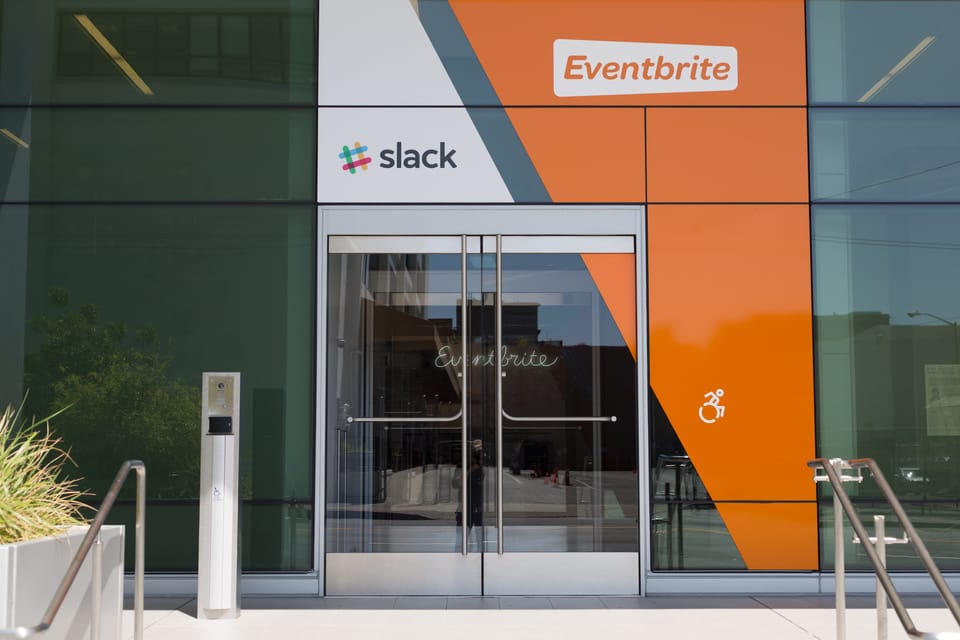
We did many things fairly well at Slack. One thing we never did well, however, was figuring out how much office space we’d need. We outgrew our Clementina Street office in July of 2014, just five months after launch. Our new office in a freshly renovated building on Folsom Street seemed impossibly large, big enough to hold us for a couple of years at least. Maybe forever? Could we possibly need to hire that many people? Surely not.
Alas. We soon found ourselves back out on the real estate market, signing a new lease for an office we’d initially rejected as too large when choosing the Folsom space. We moved to 155 5th Street in March 2015, just nine months later.
The new space was a vast empty square. The kitchen, meeting rooms, and elevators sat in the middle. When we moved in we barely had enough people to fill one side of the square. The other three sides sat vacant, stacked with computer monitors, office chairs, and desks yet to be assembled.
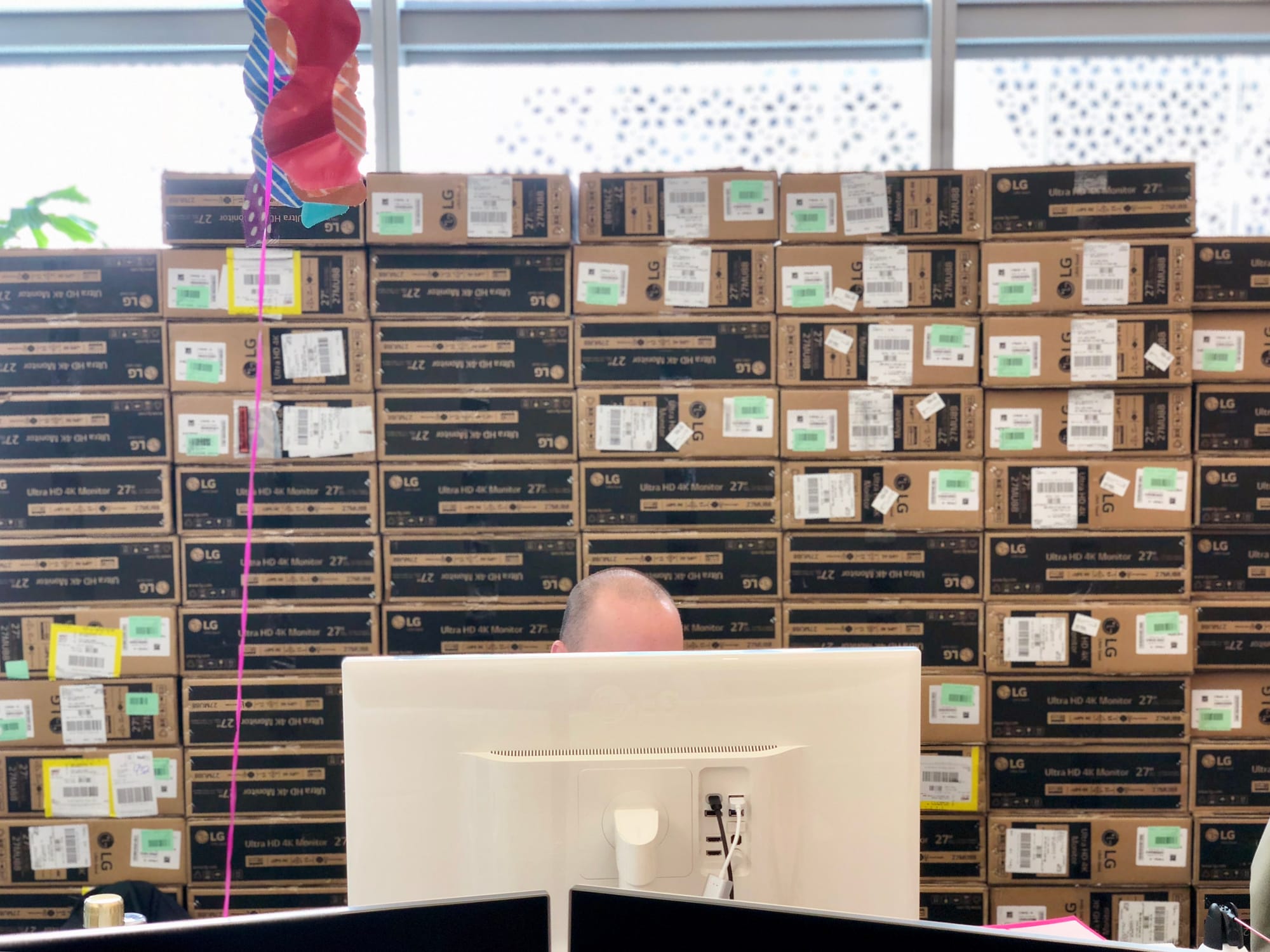
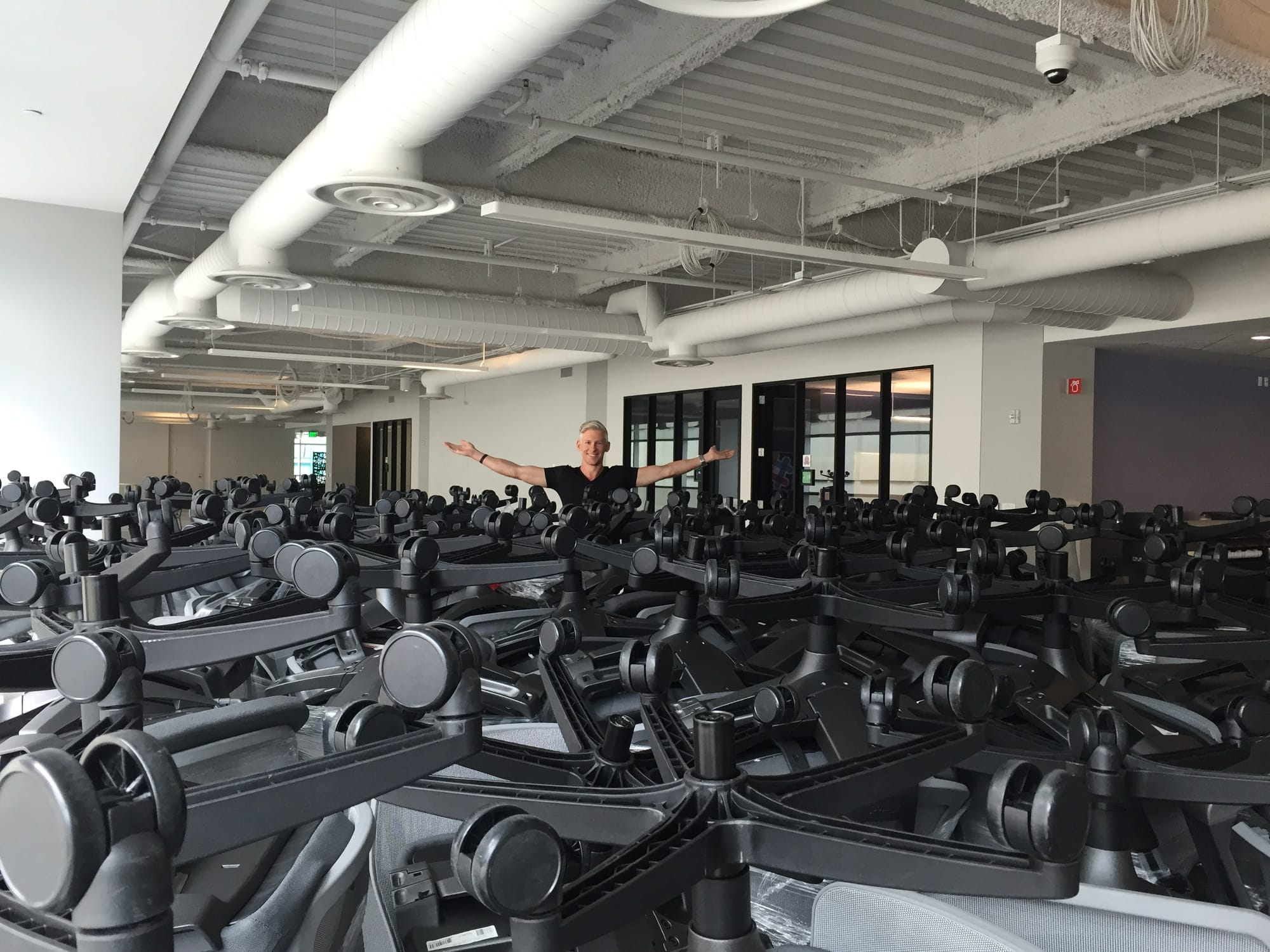
Preparing for our next hundred hires.
Day by day, the desks filled. We were hiring rapidly, with a dozen or more new people starting every week. At this point we had about 125 people across our offices in San Francisco, Vancouver, and Dublin.
We were no longer just hiring the engineers, designers and customer support staff we needed to build and support the product. We were hiring whole new departments of people to run the offices, set up IT systems, and accelerate the rate at which we’d hire, onboard, and manage the next wave of employees.
Many of our very early hires were friends and former colleagues. This had the effect of self-selecting for people with similar working styles. They came in already knowing what to expect of the culture.
By the end of 2014, however, most of those we hired were people we’d never worked with before. They didn’t have the luxury of knowing, specifically, what it looked like to work at Slack. We realized that for them to succeed and thrive, and for Slack to grow into the Slack we wanted it to be, those implicit expectations needed to be made explicit. The DNA of the company – born out of its history, its quirkiness, and the pragmatic priors of its founders – needed to be both preserved and formalized.
When we moved into our vast empty square of an office in 2015, Stewart and Cal recognized that time was short to get this work done — they were now in charge of a smallish company that was about to get very big. Yahoo!’s acquisition of Flickr gave Slack’s founders a crash course in the dysfunction and confusion of a large tech company that grew too fast. We didn’t want that. We all wanted to build a company we could continue to love working for.
We needed to distill our values down into something that would guide how we hired, what we built, how we treated our customers, and how we treated one another.
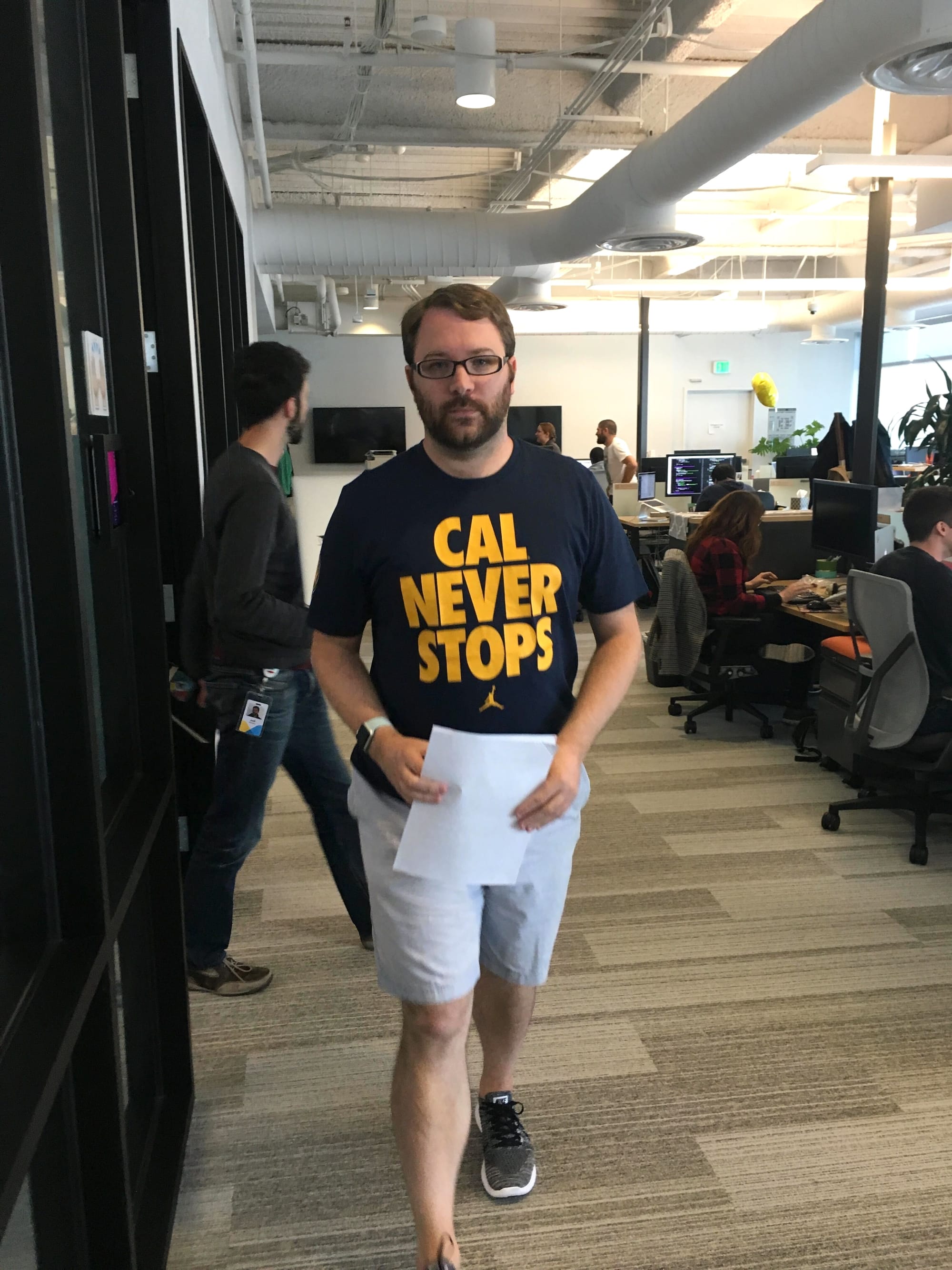

Writing down our values
On a sunny day in the spring of 2015, Stewart gathered a small set of early employees and leaders at the company. He projected a list of company values on the screen in bold block letters:
- INTEGRITY
- COMMUNICATION
- RESPECT
- EXCELLENCE
“Guess which company has these values?” he asked. After a beat, he delivered the punchline: “Enron.” A byword for corporate fraud, corruption and failure. “We’re not allowed to have any of these words in our values. Integrity is probably in the corporate values of half the Fortune 500. And look at how they behave.”
His point? Words don’t mean much if you don’t actually live up to and embody their meaning in how you work. We needed to establish both what we wanted our unique values to be and how we would operationalize them.
Most startup artifacts are framed as “living documents,” things that are true when they’re written but will need to be revised regularly as the company grows and changes. A company’s list of values is not one of these living documents. When done well, the document that captures a company's values is a durable love letter to the best of what that company is, and an aspirational reminder to each employee about what it can be going forward.
When used well, company values become a powerful tool in scaling both decision-making and behavior throughout an organization. They are a cheat sheet everyone can use when faced with an unfamiliar situation or an uncomfortable tradeoff. They narrow the list of potential decisions, creating more predictability. What turns them from a list of words to a culture-supporting force is consistency — day after day, year after year, decision after decision, and people at every level of the organization choosing to live by them.
This is a lot of weight to put on a few words — we had our work cut out for us. We split up into small groups of 3 or 4 and started brainstorming on the flipcharts that were scattered around the room. Words quickly filled the sheets, sometimes decorated with doodles or expanded with short anecdotes. We discussed which things we were doing that we wanted to make sure we kept, and those we might want to change. We tried to imagine how to convey the culture we had to the next hundred or thousand people that would join the company.
After coffee, we regrouped and collated all the notes. Ten or so themes began to emerge as we winnowed a list down from dozens of ideas. Words being words, many of the ideas expressed varying interpretations of similar concepts. We worked to determine whether each idea supported our mission, which we’d written down very soon after we pivoted from Glitch:
To make people’s working lives simpler, more pleasant, and more productive.
Several ideas nearly made the cut but were discarded after discussion. “Fairness” was a value we believed in, but were concerned could be weaponized in destructive ways. “Purposefulness” was appealing but hard to say and perhaps duplicative of the mission.
We argued about wording. Stewart, in typical philosophical form, wanted to convey the Greek concept of “eudaimonia”: good-spiritedness and living life in accordance with purpose and virtue. Needless to say, this was an unfamiliar term to most of us. We landed on Thriving.
Eventually we arrived at a set of six thoughtful, humane values that felt complete. We didn’t feel we could remove any of them. We added supporting examples we hoped would articulate what each meant.
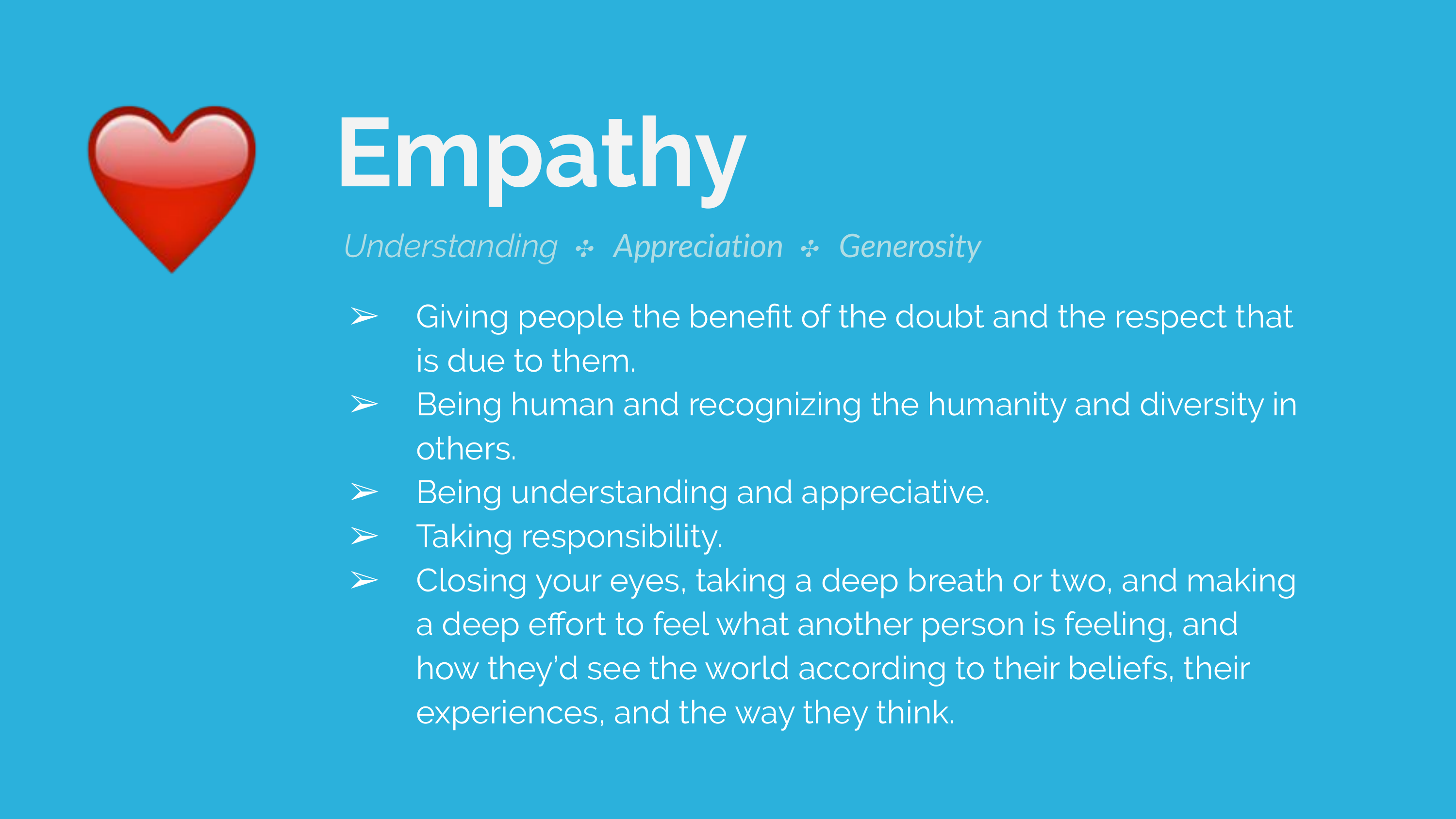
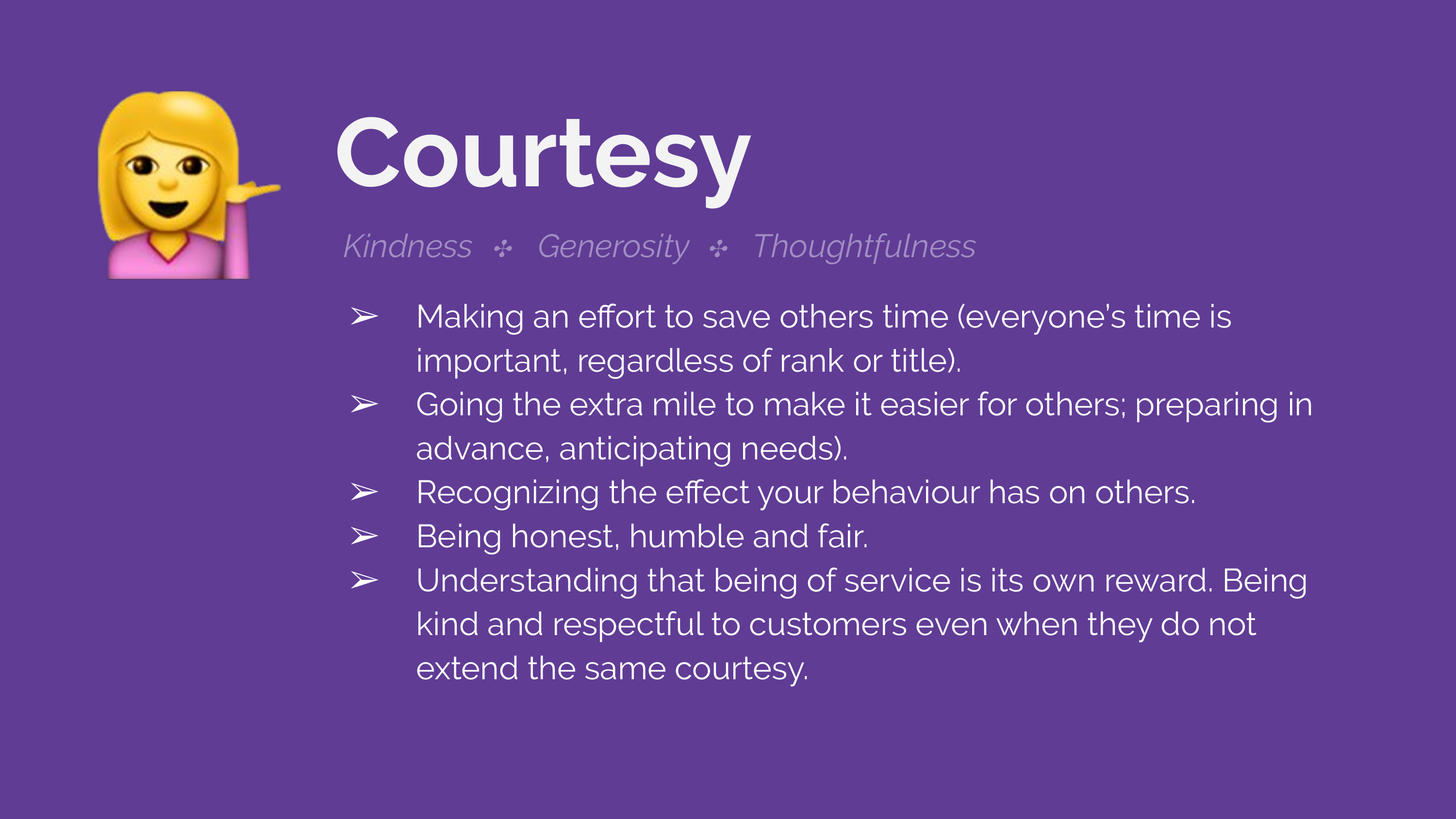
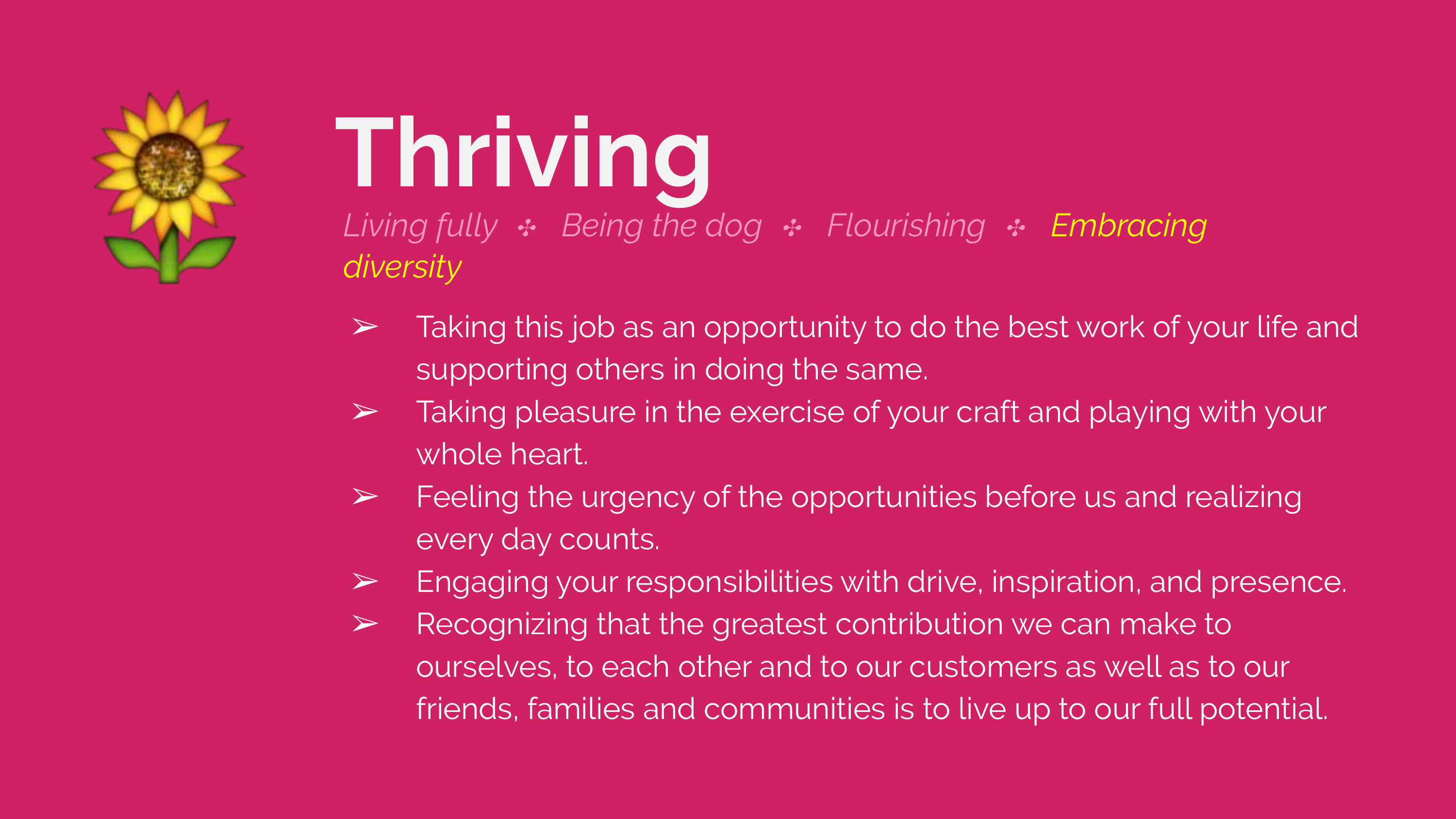
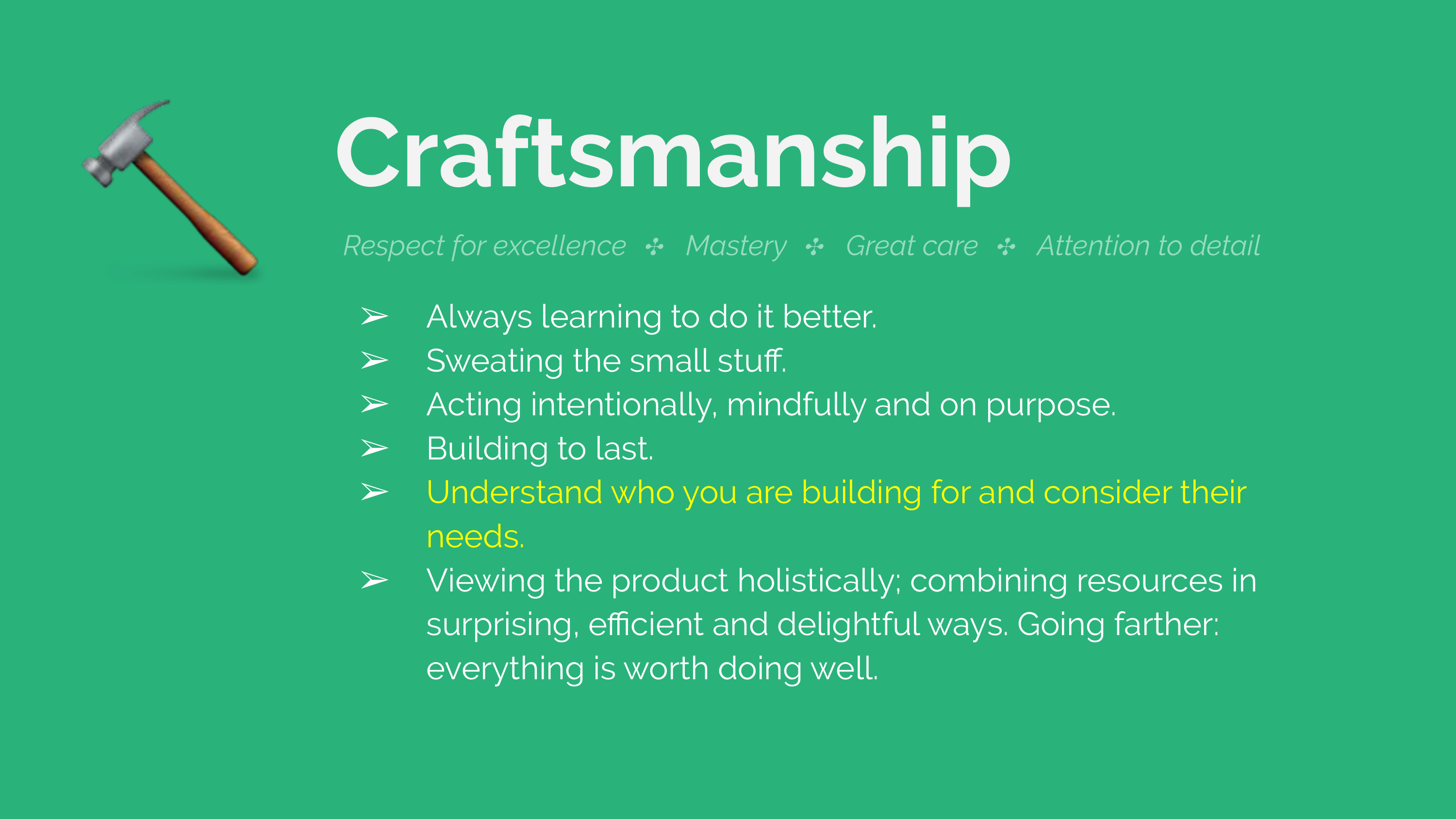
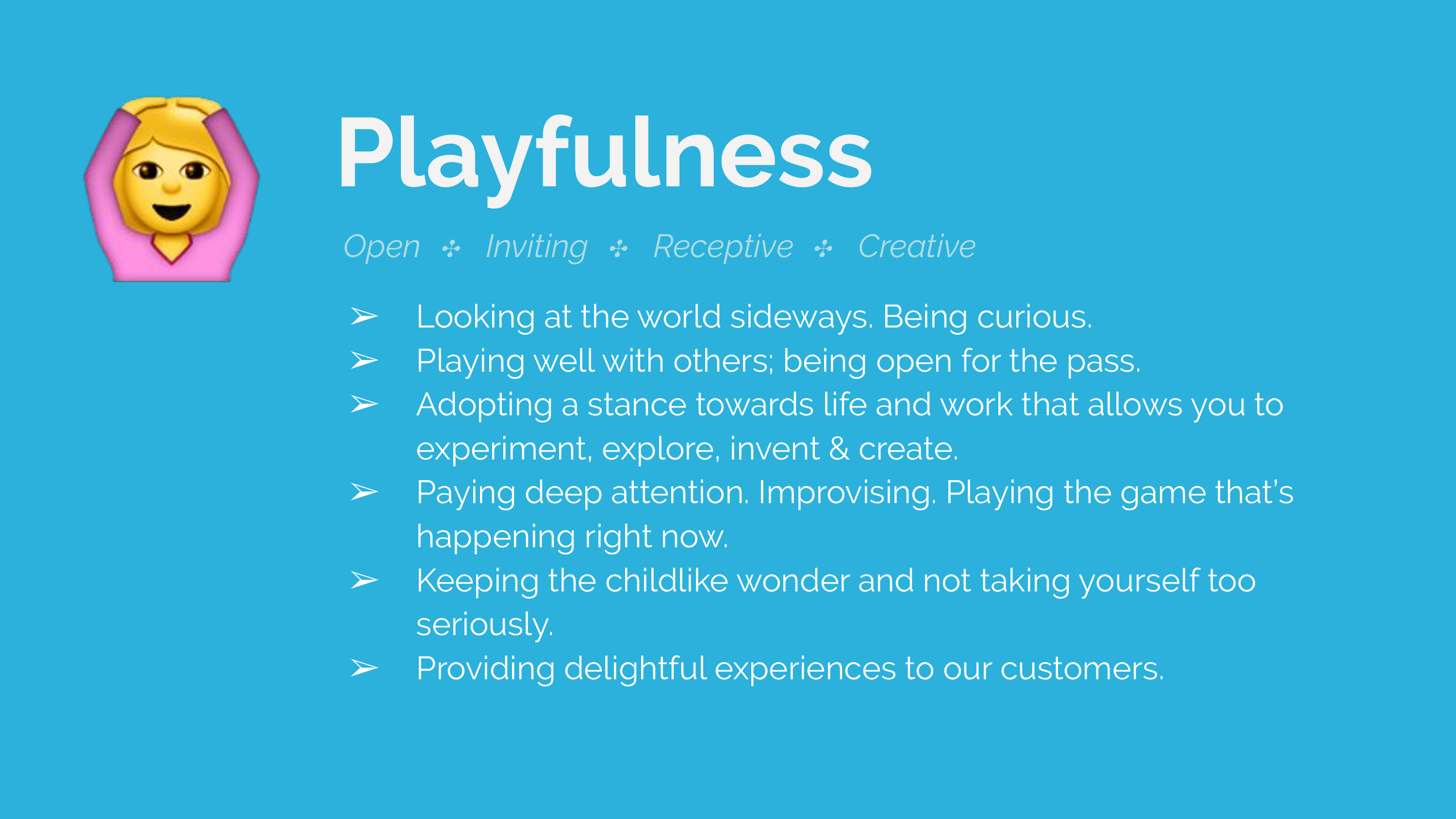
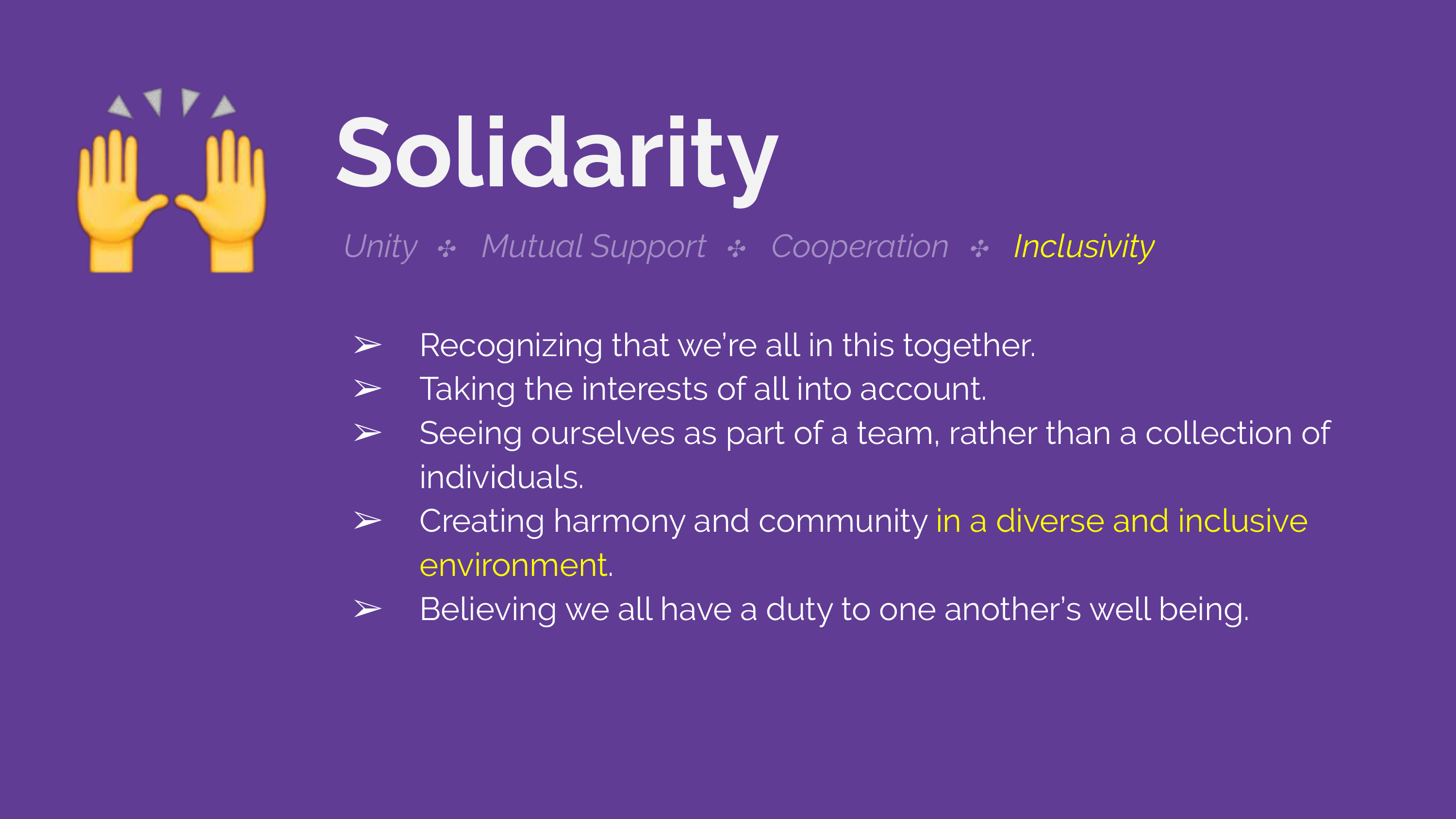
Empathy
Understanding · Appreciation · Generosity
- Giving people the benefit of the doubt and the respect that is due to them.
- Being human and recognizing the humanity and diversity in others.
- Being understanding and appreciative.
- Taking responsibility.
- Closing your eyes, taking a deep breath or two, and making a deep effort to feel what another person is feeling and how they’d see the world according to their beliefs, experiences, and the way they think.
Courtesy
Kindness · Generosity · Thoughtfulness
- Making an effort to save others time (everyone's time is important, regardless of rank or title).
- Going the extra mile to make it easier for others; preparing in advance, anticipating needs.
- Recognizing the effect your behavior has on others.
- Being honest, humble, and fair.
- Understanding that being of service is its own reward. Being kind and respectful to customers even when they do not extend the same courtesy.
Thriving
Living fully · Being the dog · Flourishing · Embracing diversity
- Taking this job as an opportunity to do the best work of your life and supporting others in doing the same.
- Taking pleasure in the exercise of your craft and playing with your whole heart.
- Feeling the urgency of the opportunities before us and realizing every day counts.
- Engaging your responsibilities with drive, inspiration, and presence.
- Recognizing that the greatest contribution we can make to ourselves, to each other, and to our customers as well as to our friends, families, and communities is to live up to our full potential.
Craftsmanship
Respect for excellence · Mastery · Great care · Attention to detail
- Always learning to do it better.
- Sweating the small stuff.
- Acting intentionally, mindfully, and on purpose.
- Building to last.
- Understand who you are building for and consider their needs.
- Viewing the product holistically: combining resources in surprising, efficient, and delightful ways. Going farther; everything is worth doing well.
Playfulness
Open · Inviting · Receptive · Creative
- Looking at the world sideways. Being curious.
- Playing well with others; being open for the pass.
- Adopting a stance towards life and work that allows you to experiment, explore, invent, and create.
- Paying deep attention. Improvising. Playing the game that's happening right now.
- Keeping the childlike wonder and not taking yourself too seriously.
- Providing delightful experiences to our customers.
Solidarity
Unity · Mutual Support · Cooperation · Inclusivity
- Recognizing that we’re all in this together.
- Taking the interests of all into account.
- Seeing ourselves as part of a team, rather than a collection of individuals.
- Creating harmony and community in a diverse and inclusive environment.
- Believing we all have a duty to one another’s well-being.
These were eventually paired with matching emoji. At the time, emoji profusion was in full swing, with Slack at the forefront of bringing this type of communication into the workplace via messaging and reactions. We leaned into that and ended up with our final list of Core Values:
- ♥️ Empathy
- 💁 Courtesy
- 🌻 Thriving
- 🔨 Craftsmanship
- 🙆 Playfulness
- ✊ Solidarity
So did the values work?
Putting a set of words on slides and slogans on the wall sets expectations. They expressed what made Slack different and what it stood for. The ideas were reinforced frequently: on the first day of every employee’s onboarding, in All Hands meetings, in hiring decisions, in playbooks for how to treat potential and current customers, and in how we recognized top performers.
Eventually we learned that, in practice, any value you write down has a shadow value. Empathy was at times weaponized the way we feared Fairness might be, and was used as an excuse to avoid tough-but-valid criticism. Craftsmanship could be used as an excuse for perfectionism and the delays that entailed. Thriving could tip into excessive self-care.
But for many the Values resonated with the unique culture we created at Slack, and were a point of pride and purpose during the daily grind. Though imperfect, they remained durable over time and are still on the Slack Careers page ten years later.


Caloween (where everyone dressed up as Cal for his birthday) one year apart at Folsom and 5th Street.
Thank you to Cal Henderson, Merci Grace, and Jamie Rosenfield for their input and feedback on this post. Thanks to Myles Grant and Scott Schiller for sharing their photos.
